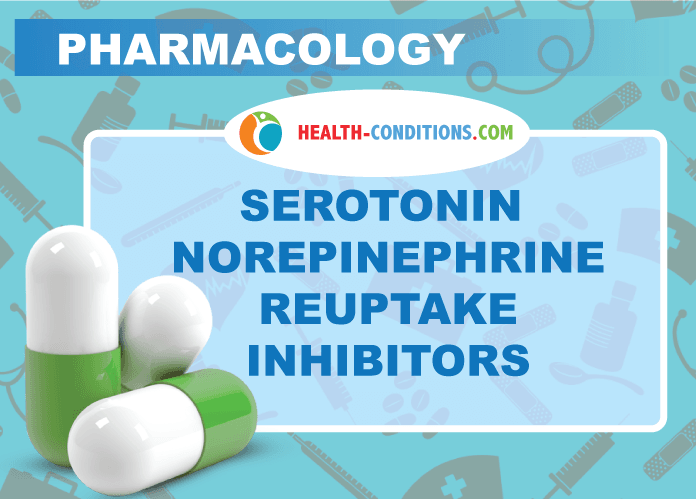SNRIs (Serotonin Norepinephrine reuptake inhibitors)
GENERAL DESCRIPTION
SNRIs are antidepressants which work by inhibiting both serotonin and norepinephrine reuptake transporter. SNRIs are the most prescribed antidepressants now a days.
| Class | Generic Name | Brand Name |
|
SNRIs (Serotonin nor epinephrine reuptake inhibitors) |
Venlafaxine | Effexor |
| Desvenlafaxine | Desfax, Pristiq, Ellefore | |
| Duloxetine
|
Cymbalta | |
| Levomilnacipran
|
Fetzima |
MECHANISM OF ACTION
SNRIs work by elevating certain neurotransmitter in the brain. At presynaptic serotonergic neuron, this interact with postsynaptic neuron which have postsynaptic receptors which are 5-HT. serotonin is synthesized from amino acid tryptophan by serotonergic neurons. These serotonin is stored in vesicles for regulated release.
At presynaptic noradrenergic neuron, this interact with postsynaptic neuron which have postsynaptic receptors which are β and α1. Norepinephrine is synthesized from amino acid tyrosine by noradrenergic neurons and stored in vesicles awaiting regulated release.
When serotonin and NE release from the neuron they stimulate their receptors and at the same time they transported back to their neurons by a process called reuptake. Serotonin is reuptake by serotonin transporter or SERT and norepinephrine is transported back to their neuron by norepinephrine transporter or NET. Once both chemicals reabsorb they partially repacked in synaptic vesicles in partially broken down into inactive metabolites by an enzyme monoamine oxidase or MAO.
SNRIs work by inhibiting both serotonin and norepinephrine reuptake transporter i.e. SERT and NET, which result in increased levels of both serotonin and norepinephrine which can then bind to their respective postsynaptic receptors.
PHARMACOKINETICS
SNRIs are orally active drug, absorb in the body through digestion. The average half-life of SNRIs is 5 hours. Some drugs have active metabolites. Venlafaxine and trazodone have short plasma half-life and required divided doses.
INDICATIONS
Depression
Chronic musculoskeletal pain
Anxiety and panic disorders
Obsessive compulsive disorder
Attention deficit hyperactivity disorder
Menopausal symptoms relief
Reducing pain associated fibromyalgia and other pain caused by neuropathy. It is due to enhance noradrenergic activity in the central nervous system.
CONTRAINDICATIONS
Hypertension
Hepatic failure
Renal failure
Alcohol
Coronary artery disease
Eating disorder (bulimia or anorexia)
Uncontrolled narrow angle glaucoma (duloxetine and milnacipran)
MAOIs
SIDE EFFECTS & ADVERSE EFFECTS
Manic episodes
Decrease libido
Weight gain
Insomnia
Increase in anxiety
Irritability
Sexual side effects include erectile dysfunction
Nausea
Vomiting
Diarrhea
Abrupt with drawl may cause temporary deficiency of serotonin which may lead to headache, nausea, vomiting, agitation, sleep disturbance.
Serotonin syndrome
Increase blood pressure and heart rate
DRUG INTERACTION
Nefazodone may cause acute hypotension and weakness when given with venlafaxine.
Nefazodone is contraindicated with other serotogenic antidepressants.
Cimetidine may increase the plasma level of venlafaxine and duloxetine.
The concurrent use of venlafaxine and propafenone may cause psychosis
Duloxteine is contraindicated with concurrent use of MAOI and SSRIs.
Ciproflozacina, enoxacin and quinidine may increase the plasma levels of duloxetine.
Duloxetine may increase the levels of thioridazine and flecainide
The concurrent use of venlafaxine with co-amoxiclav or dexamphetamine or metoclopramide or tramadol may cause serotonin syndrome.
Diphenhydramine, melperone, quinidine, thioridazine may inhibit the metabolism of venlafaxine.
Venlafaxine and disulfiram may cause hypertensive crisis.
Venlafaxine may increase the antimuscarinic effects of TCAs.
NURSING INTERVENTIONS
Enquire the complete health history of the patient including allergy, drug interactions, and family background of depression
Check lab test for CBC, blood glucose, BUN, creatinine, platelets, electrolytes, LFT
Check and identify if any neurological disorder like seizure etc.
Monitor blood pressure and pulse before and during treatment
Administer medicine at night or bed time to avoid drowsiness at day time
Observe mood swing during the treatment
Observe s/s for serotonin syndrome, if any
Observe cardiovascular or neurologic s/s for any disorder, if any
Avoid to administer MAOIs with tyramine containing food
Observe sleep-wake cycle of the patients.
PATIENT EDUCATION
IF taken MAOIs, forbid patient to take any fermented or aged food or containing tyramine.
Advise to take medicine at night or bed time to avoid drowsiness at day time and take morning dose early to avoid insomnia.
Advise patient not to discontinue treatment because it may take 2-4 weeks to start antidepressant effects
Inform the patients about the possible side effects of medication specially serotonin syndrome which may be life threatening.
Report immediately if feeling bradycardia, urinary retention, blurred vision, chest pain, and diaphoresis.
Advice to take care and slow change of posture due to dizziness and danger of fall or injuries.
Avoid driving if feeling drowsiness or dizziness.
Do not breast breast feed while taking medicine.













